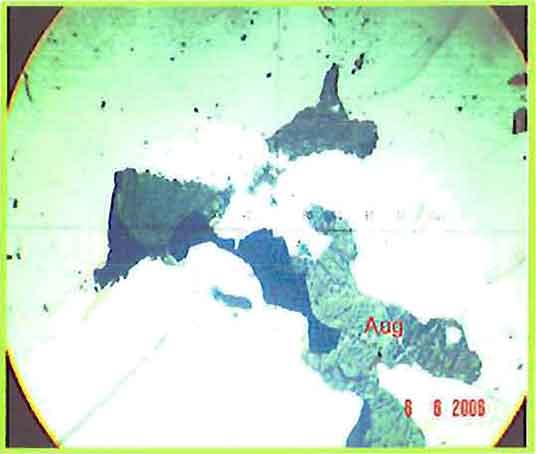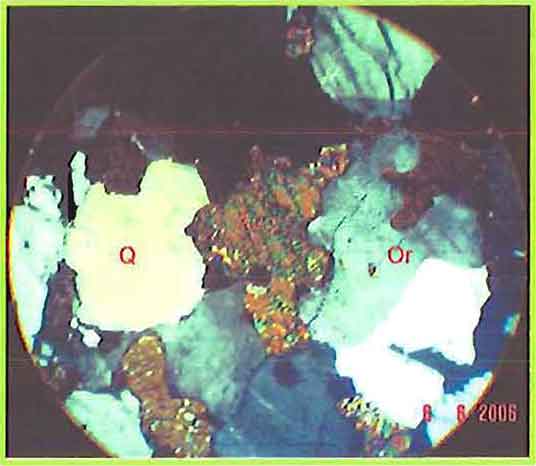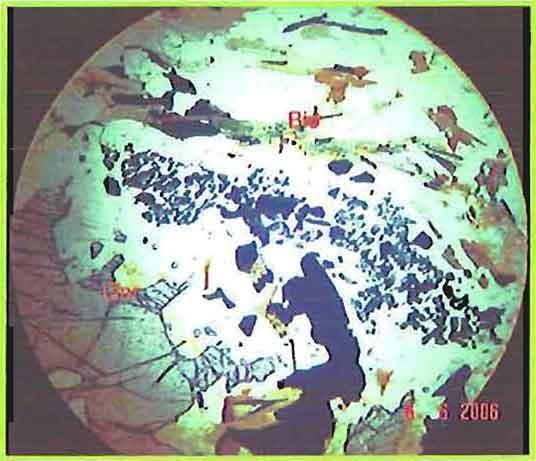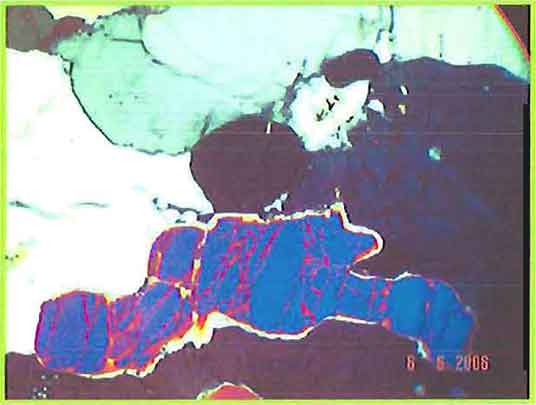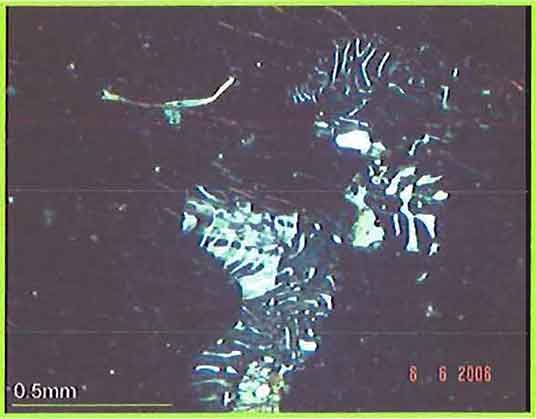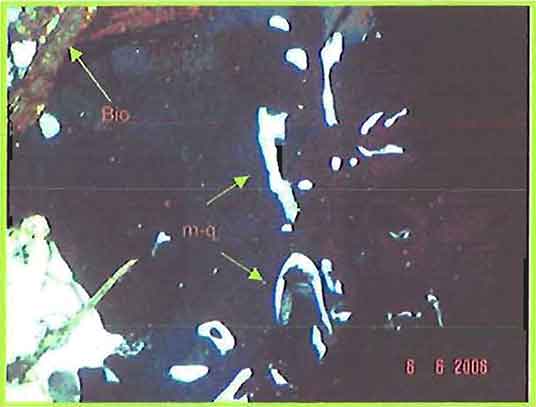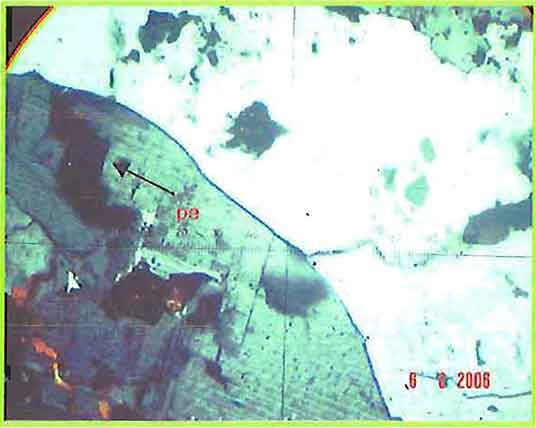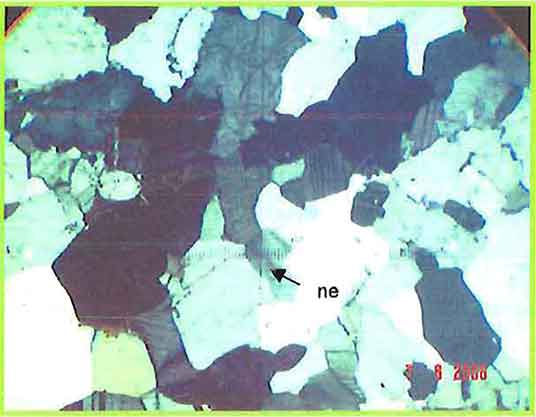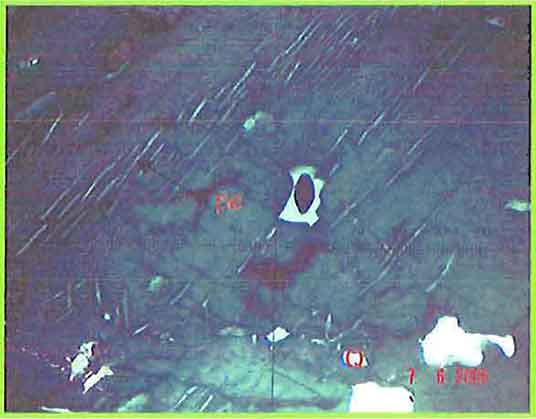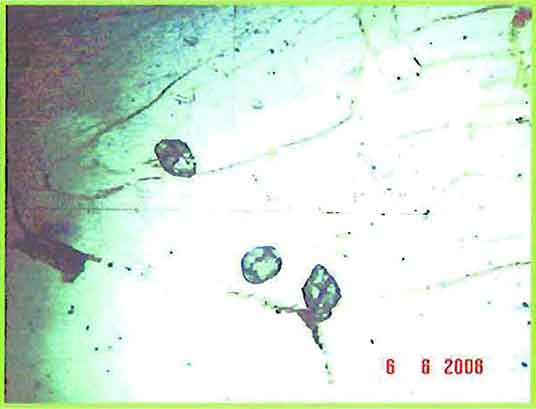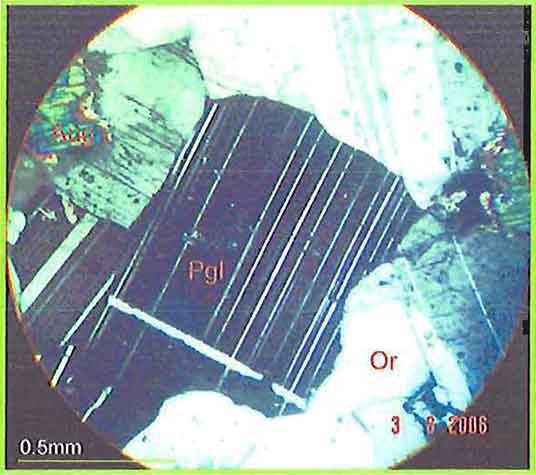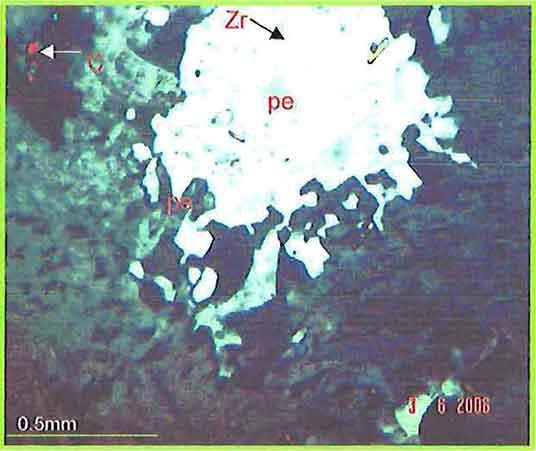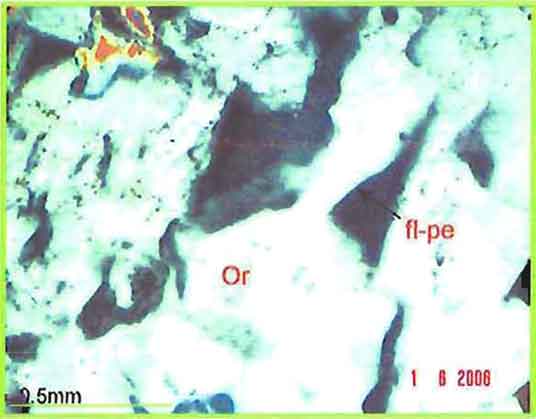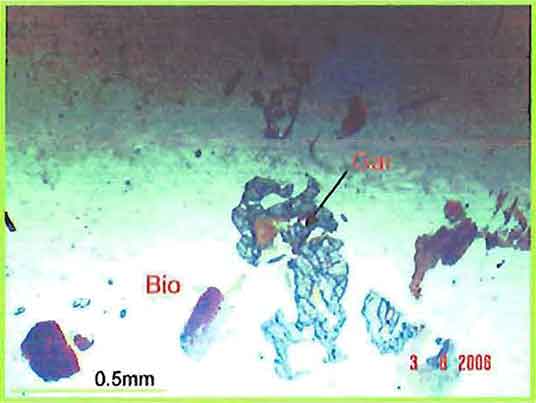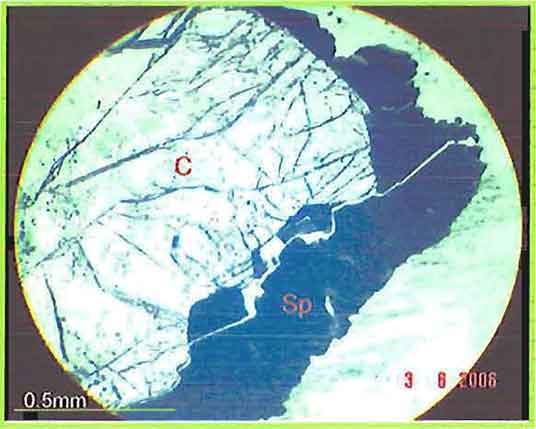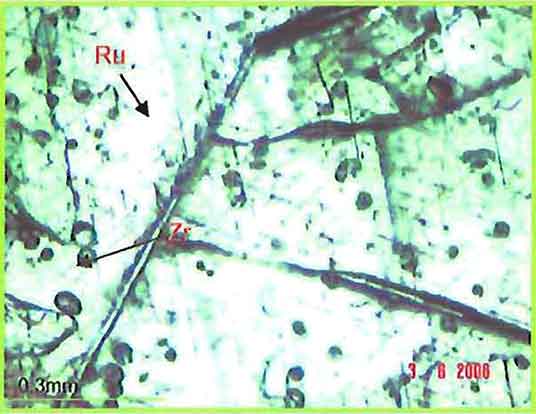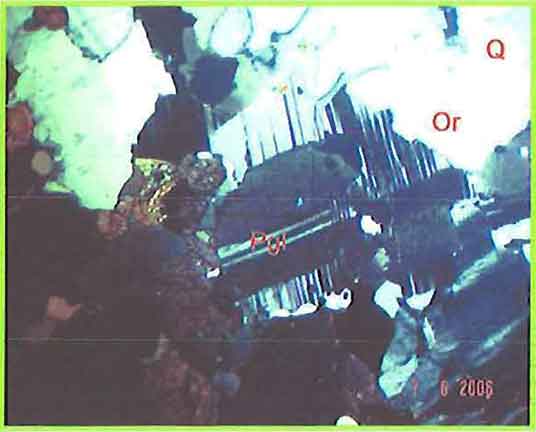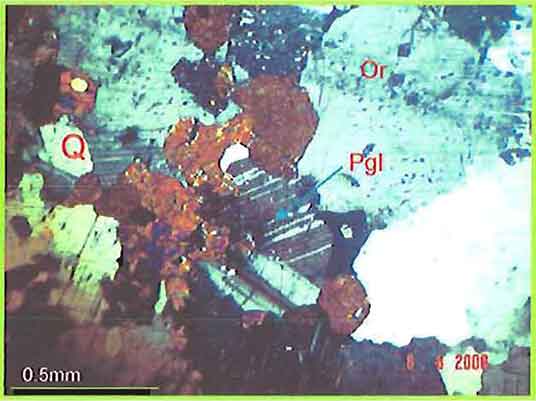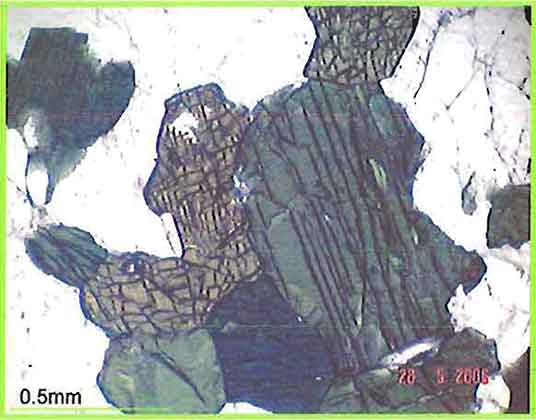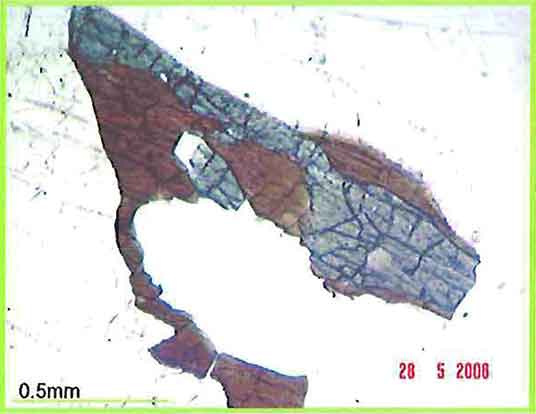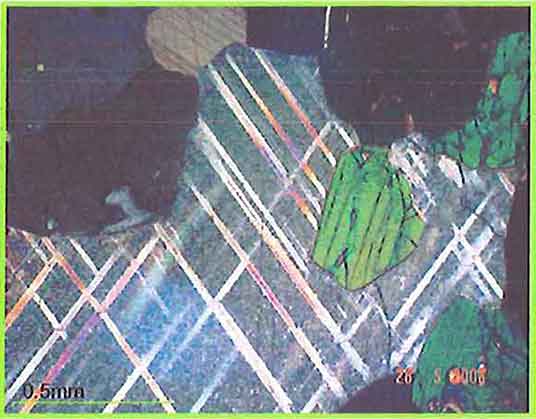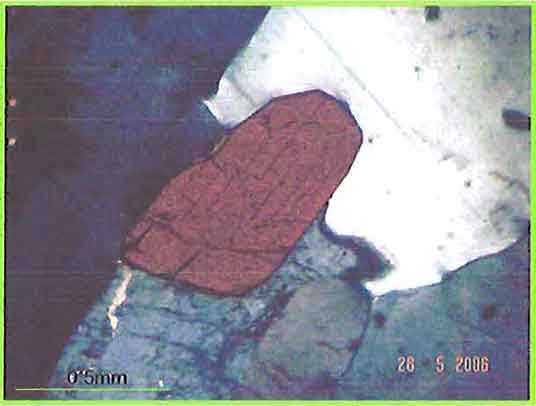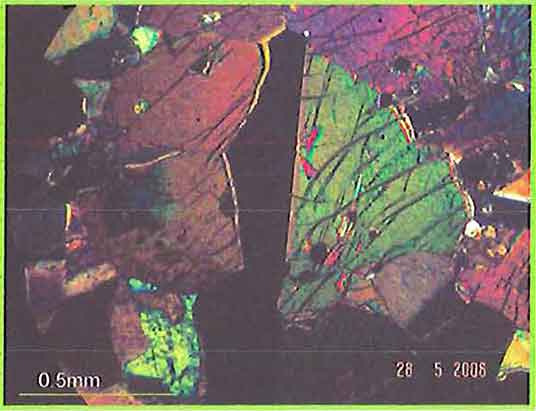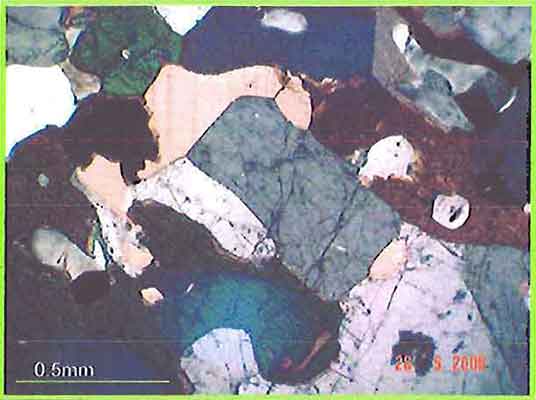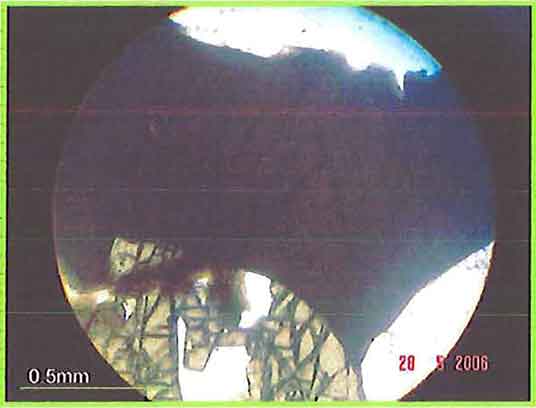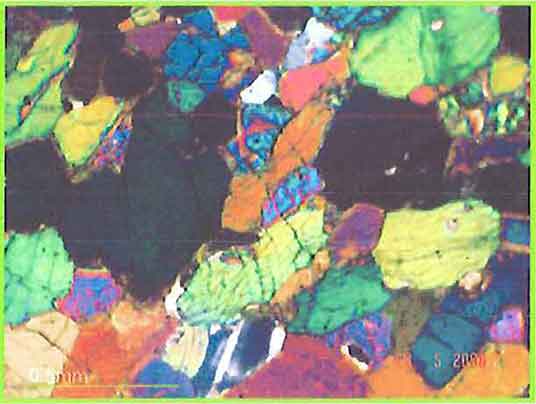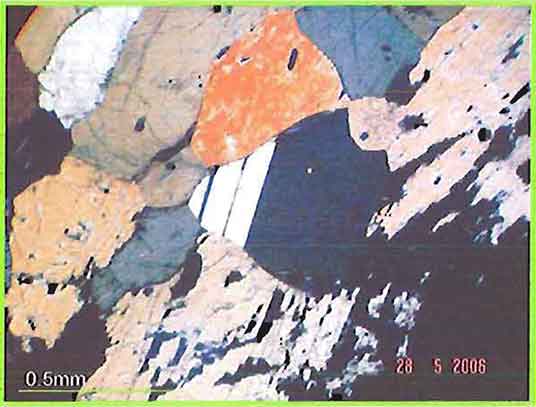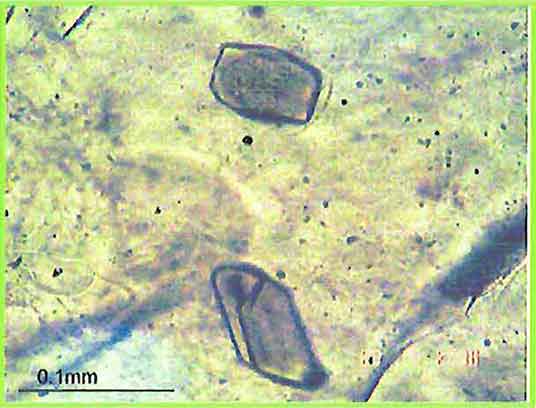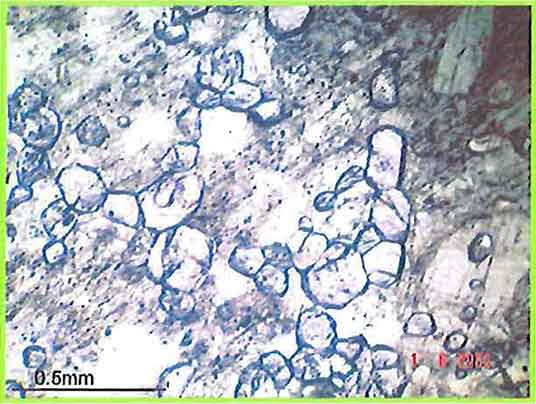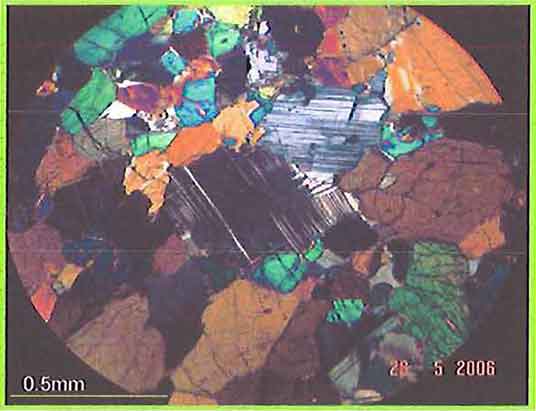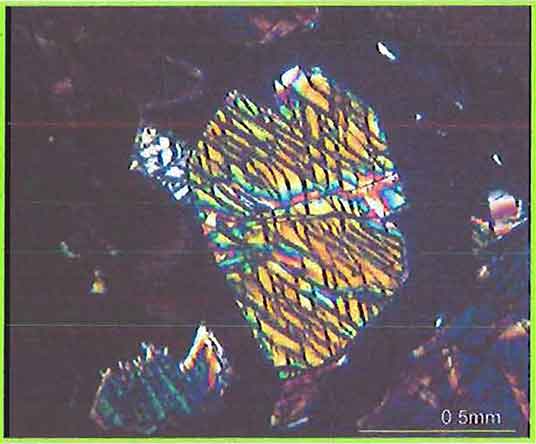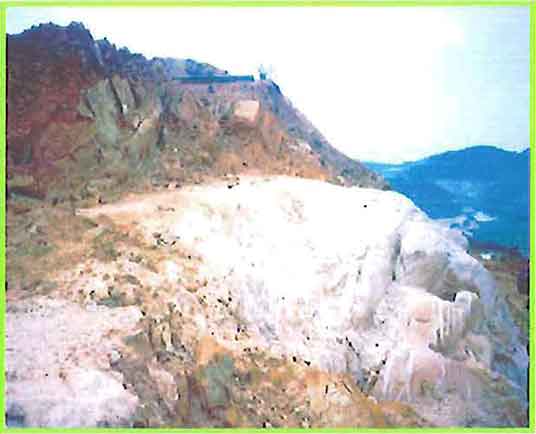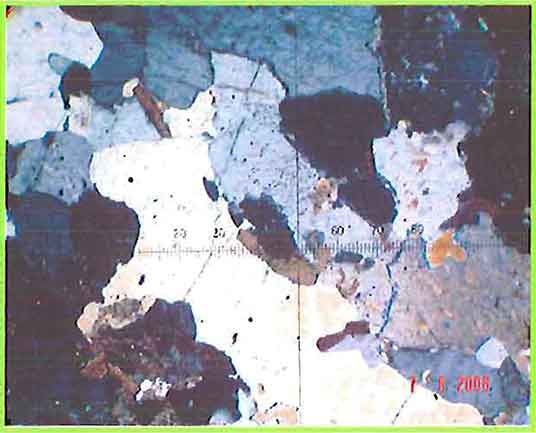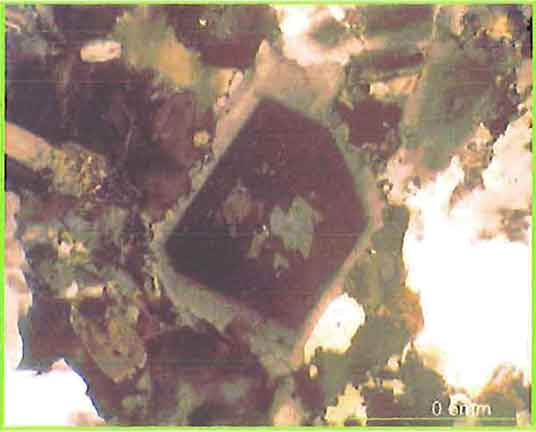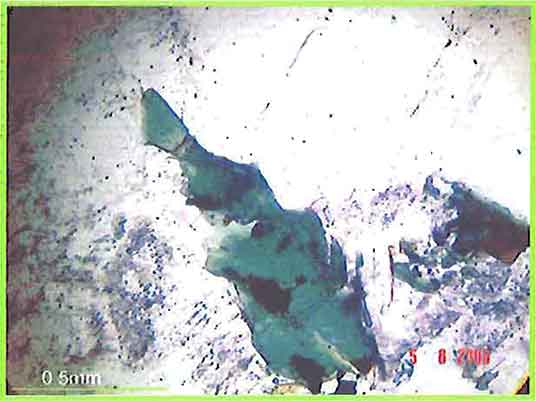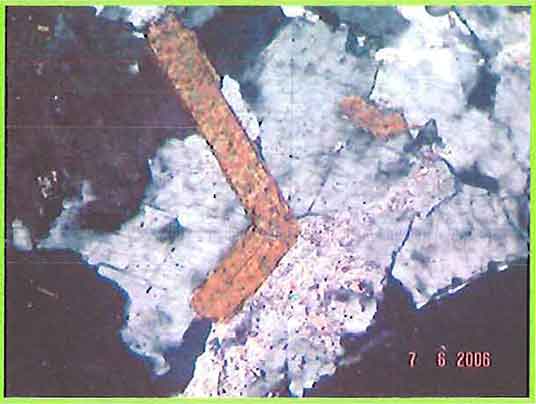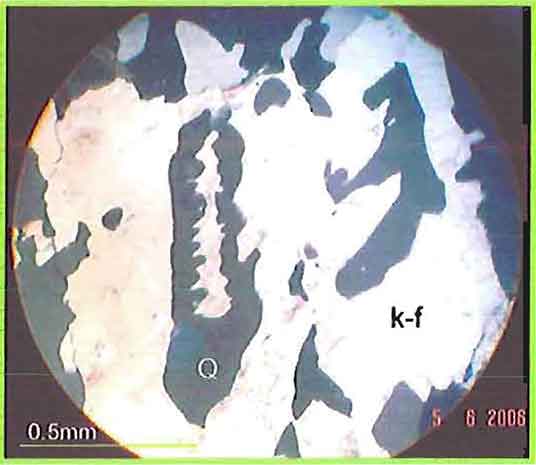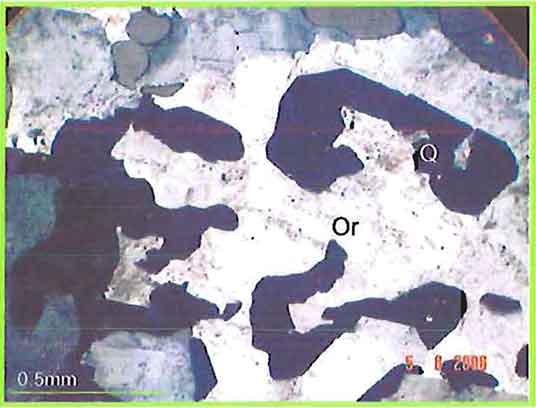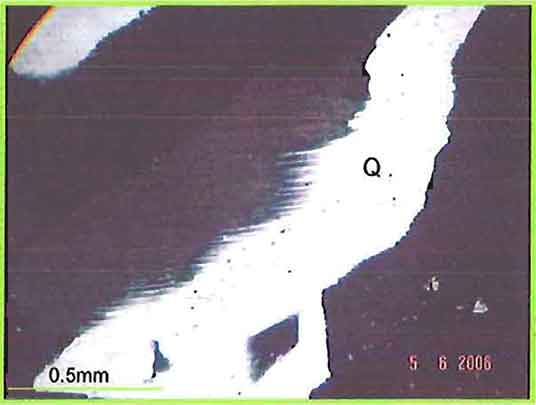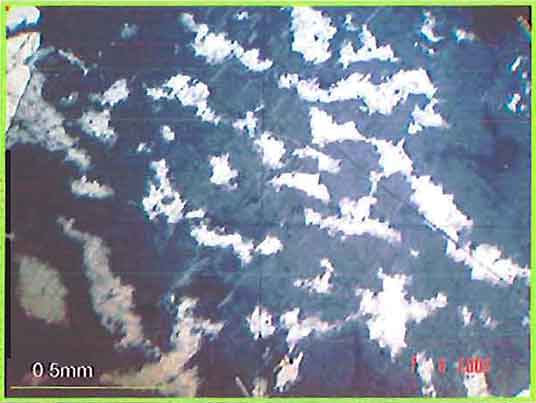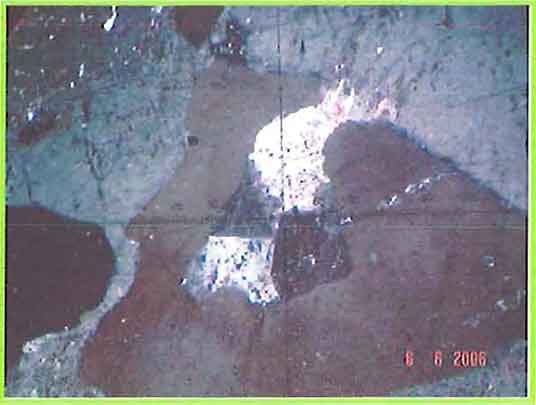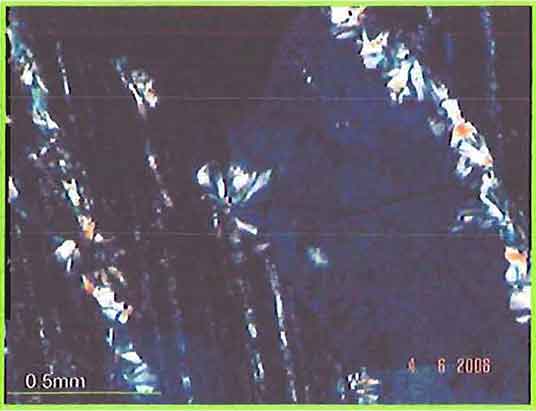![]()
Chapter III Part 2
The Igneous Rocks of the Mogok Stone Tract
A Ph.D. Dissertation by Kyaw Thu
Department of Geology, University of Yangon, Myanmar
Copyright © Kyaw Thu, 2007
Contents
See complete table of contents here.
Chapter III Petrography
3.1 Ultramafic and Mafic Rocks
3.2 Augite-biotite Granite
3.3 Leucogranite
3.4 Syenitic Rocks
3.5 Urtite Series
3.6 Kabaing Granite
3.7 Pegmatites and Aplites
References
List of Figures (images from Pala International are not listed)XN = crossed Nicols (explained here); PPL = plane polarized light (explained here) |
|
| 3.29 | Anhedral aegirine augite (Aug) grain in quartz syenite, PPL, 10 X |
| 3.30 | Quartz syenite containing alkali feldspar (Or), aegirine augite (Aug), and quartz (Q), XN, 10 X |
| 3.31 | Anhedral garnet (Gar) grain, iron ore and biotite (Bio) showing foliation in quartz syenite, PPL, 10 X |
| 3.32 | Anhedral and basal section of scapolite grains in quartz syenite from contact zone, XN, 10 X |
| 3.33 | Myrmekitic intergrowth of quartz and plagioclase feldspar in quartz syenite, XN, 25 X |
| 3.34 | Myrmekitic (m-q) intergrowth of quartz and feldspar, and biotite (Bio) in alkali-feldspar syenite, XN, 25 X |
| 3.35 | K-feldspar showing grid twinning with patch perthite (pe) in alkali-feldspar syenite XN, 25 X |
| 3.36 | Subhedral nepheline (ne) crystal in foid-bearing alkali-feldspar syenite, XN, 10 X |
| 3.37 | K-feldspar with perthitic (pe) veinlets and opaque mineral in quartz syenite, XN, 25 X |
| 3.38 | Euhedral sphene crystals in alkali-feldspar of foid-bearing alkali-feldspar syenite, PPL, 25 X |
| 3.39 | Euhedral plagioclase (Pgl) crystal showing polysynthetic twinning in alkali syenite pegmatite, On-dan, XN, 25 X |
| 3.40 | K-feldspar with flame perthite (pe) enclosing zircon crystal and corundum grain, On-dan, XN, 25 X |
| 3.41 | K-feldspar (Or) with flake perthite (fl-pe) in alkali-syenite pegmatite, XN, 25 X |
| 3.42 | Garnet (Gar) and biotite (Bio) flakes in alkali-syenite pegmatite, Lay-thar, PPL, 10 X |
| 3.43 | Corundum (C) crystal enclosed in spinel (Sp), alkali-syenite pegmatite, Lay-thar, PPL, 10 X |
| 3.44 | Corundum showing typical three sets of short rutile (Ru) needles and small zircon (Zr) inclusions in alkali-syenite pegmatite, PPL, 25 X |
| 3.45 | Plagioclase (Pgl) showing pericline twinning in quartz monzonite, XN, 10 X |
| 3.46 | Complex polysynthetic twinning in plagioclase (Pgl) and augite in quartz monzonite, XN, 10 X |
| 3.47 | Hornblende and pyroxene and the rest white colour is nepheline in urtite, PPL, 25 X |
| 3.48 | Pyroxene is partly altered to hornblende in urtite rock, PPL, 25 X |
| 3.49 | Calcite showing twinning and amphibole in urtite, XN, 25 X |
| 3.50 | Euhedral biotite crystal in urtite, XN, 25 X |
| 3.51 | Amphibole showing simple twin in urtite, XN, 10 X |
| 3.52 | Rectangular shaped nepheline, hornblende and calcite in urtite, XN, 10 X |
| 3.53 | Anhedral deep yellowish brown, titanium rich melanite garnet and augite in urtite, PPL, 10 X |
| 3.54 | Mineral constituents of the ijolite containing hornblende, augite, nepheline, iron ore and plagioclase feldspar, XN, 10 X |
| 3.55 | Feldspar showing combination of Carlsbad and albite twin, hornblende and nepheline in ijolite, XN, 10 X |
| 3.56 | Euhedral zircon crystal in nepheline, PPL, 25 X |
| 3.57 | Small corundum grains in ijolite, Thurein Taung, PPL, 25 X |
| 3.58 | Mineral constituents of jacupriangite include hornblende, pyroxene, and plagioclase showing pericline twinning, XN, 10 X |
| 3.59 | Basal section of hornblende in jacupriangite, XN, 25 X |
| 3.60 | Kabaing granite intruded into the dunite body in Pyaung-gaung, 23° 00' 18.4" N, 96° 27' 8.5" E |
| 3.61 | Mineral constituents of biotite microgranite includes quartz, feldspar and biotite mica, XN, 10 X |
| 3.62 | Euhedral alkali-feldspar shows zoning with some biotite in Kabaing granite, XN, 10 X |
| 3.63 | Chlorite, alteration product of biotite in Kabaing Granite, PPL, 25 X |
| 3.64 | Elongated bioite crystal showing bent nature due to deformation, 52 XN, 25X |
| 3.65 | Granophyric quartz (Q) in K-feldspar, XN, 10 X |
| 3.66 | Graphic quartz (Q) in k-feldspar and the quartz protrudes in the orthoclase (Or) by forming indentations, XN, 10 X |
| 3.67 | Graphic quartz (Q) with extinctions into the k-feldspar, XN, 10 X |
| 3.68 | K-feldspar with perthite. Both the high proportion of perthite to k-feldspar and the irregular shapes rather suggest a metasomatic origin for the plagioclase. K-feldspar in the extinction position, XN, 10 X |
| 3.69 | K-feldspar showing rare sector twin and intergrowth with quartz, XN, 25X |
| 3.70 | Chalcedonic silica vein in k-feldspar in aplite, XN, 25 X |
| 3.71 | Plotted data of the igneous rocks in the Mogok Stone Tract, except ultramafic rocks (source; IUGS Classification, 2006) |
| 3.72 | Modal classification of ultramafic rocks based on the proportions of olivine (Ol), orthopyroxene (Opx), clinopyroxene (Cpx), pyroxene (Px) and hornblende (Hbl) (source: IUGS Classification, 2006) |
List of Tables |
|
| 3.1 | Classification of pegmatites of the rare-element class for Sakhan-gyi and Pan-taw area, after Cerny (1991) |
Chapter III Petrography – Part 2
3.4 Syenitic Rocks
The syenitic rocks have been found to vary in texture and composition from place to place from a quartz syenite to a monzonite.
According to IUGS classification, it can be classified into the following subunits:
- Quartz-syenite
- Alkali-feldspar syenite
- Foid-bearing alkali-feldspar syenite
- Alkali-feldspar syenite pegmatite
- Quartz monzonite
Megascopic Study
It is whitish to brownish yellow coloured, phaneritic rock. It shows medium to coarse-grained, sometimes pegmatitic texture. Feldspar is the most predominant mineral, and it is orthoclase with moonstone schiller and with a subordinate quantity of pyroxene and a little quartz. Sapphire, garnet, spinel, biotite, tourmaline, graphite and iron ore are occasionally present.
- Quartz-syenite
Microscopic Study
It is medium to coarse-grained, hypidiomorphic granular texture, and principally composed of alkali-feldspar, quartz, a little plagioclase, aegirine augite, and common hornblende. Subordinate amount of garnet, biotite, apatite, zircon, sphene and iron ore are common. Alkali-feldspars are usually perthitic intergrowth, mostly cryptoperthite to microperthite and which are higher % than plagioclase.
Flame, patch, film and string perthites are common and perthitisation is simply an exsolution phenomenon in alkali-feldspars that operates within the feldspar alone, it records to cooling history after crystallization. Sometimes perthitisation are also due to metasomatic, replacement and infiltration processes. Plagioclase (An30–An35) shows subhedral crystal with combination of Albite and Carlsbad twinning and saussurited along the cracks. Quartz is usually anhedral and contains about 6–8% of total volume. The principle mafic minerals are aegirine augite, biotite with some hornblende.
- Alkali-feldspar syenite
Microscopic Study
It shows medium to coarse-grained, holocrystalline, hypidiomorphic granular texture. It is principally composed of alkali-feldspar, pyroxene and very small amount of quartz grains. Plagioclase (An28–An30) also contains a subordinate amount [of] accessory minerals include zircon, apatite, sphene and opaque minerals. Alkali-feldspar occurs as micro and cryptoperthites, and includes patch and flame perthites.
Quartz occurs as anhedral smaller grains and formed as intersticial between alkali-feldspar grains. Aegirine augite shows green to greenish colour in PPL with pyroxene cleavages in transverse sections. Sericite occurs in the fractures and grain boundaries of the alkali-feldspar.
- Foid-bearing alkali-feldspar syenite
Microscopic Study
It shows medium to coarse-grained, holocrystalline, hypidiomorphic granular texture. It is principally made up of alkali-feldspar, nepheline, cancrinite, pyroxene and a small amount of plagioclase. Accessory minerals include zircon, sphene, apatite, iron ore and sometimes include corundum grains. Alkali-feldspar occurs as micro and cryptoperthites, and includs string, patch, film and flame perthites. Subhedral plagioclase shows polysynthetic twinning is within the oligoclase-andesine range in composition. Nepheline occurs as subhedral grains and contains up to 8–10% of the rock and cancrinite is observed in some sections.
- Alkali-feldspar syenite pegmatite
Microscopic Study
This rock is rare in nature and uncommon in the geological and petrographic literature. The old name “plumasite” (after Plumas County, California where it was first discovered) was proposed by A. C. Lawson (Bulletin, Dept. of Geo., Univ. California, 1903, pp. 219–220), for a plagioclase-corundum rock forming a dyke in serpentinite. The alkali-feldspar syenite pegmatite observed in Mogok area carries more alkali-feldspar and appears similar to alkali-feldspar syenite pegmatite found in Nezametnoye deposit (Primorye region, Far East Russia). The alkali-feldspar syenite pegmatite from the Ondan, Thurein Taung, Chaung-gyi area is found intruded into marble, whereas in Laythar area itis found intruded into calc-silicate rocks.
It is coarse to very coarse-grained, holocrystalline hypidiomorphic granular texture. The rock is principally composed of alkali-feldspar, about 75% of the total volume and subordinate amount of plagioclase. Corundum, mainly sapphire is the principal accessory mineral, highly fractured, often with feldspar, rutile and zircon inclusions, and also quartz is totally absent. Sometimes, sapphire grains are closely bounded by spinel grains in alkali-feldspar groundmass.
Plagioclase also contain as subhedral grains and composition range from An45–An50 (Lay-thar, On-dan, Chaung-gyi) to An60–An65 (Thurein-taung), andesine to labradorite range. Alkali-feldspar shows colourless, cloudy, often altered to clay, as micro and cryptoperthites, showing string, patch, flake and flame perthiles. Accessory minerals include garnet, spinel, biotite, black tourmaline, zircon, scapolite, sphene and graphite flakes.
- Quartz monzonite
Microscopic Study
It is coarse-grained, hypidiomorphic granular texture. It contains alkali-feldspar, plagioclase, quartz and pyroxene and biotite, sphene and opaque minerals as accessories. Perthite exhibits string, flame, patch and film types and are suturally contacted with the surrounding minerals. Plagioclase shows subhedral crystal with polysynthetic twinning, composition ranging from An45–An50' andesine range.
Quartz occurs as anhedral grains made up of about 10–15% of the total volume. It is included within the perthite, plagioclase and orthoclase by suture contact.
3.5 Urtite Series
This suite of rocks was first discovered by Prof. Adams (1926) in Mogok area, near Sin-khwa. Similar rocks associated with marbles were described by Mr. Banerji (Fermor, 1932) near Chaung-gyi-li-shu. It is mostly mafic, but variable as to colour index, all with SiO2 < 45%, that typically lack feldspar and whose principal constituents are a pyroxene and feldspathoid (usually nepheline) (William, et al., 1982). These rocks exhibit a certain amount of variation in the mineral constituents and texture in place to place. It shows a gneissic banding, and varies in the amount of their salic and femic constituents. The constituent minerals are usually a dark brown hornblende, a dark green pyroxene, nepheline, calcite, and a little iron-ore. These rocks are typically found in Thurein-Taung, Kyauk-pyat-that area, Sin-khwa and northeast of Bernard-myo. There is a complex terminology based on colour index. In the study area, it can be classified based on mineral constituent and colour index as follows:
- Urtite
- Ijolite
- Jacupriangite
- Urtite
Megascopic Study
These rocks, first seen near Sin-hkwa, have been found to extend west and south-west towards Lon-sho, Kyauk-pyat-that and Yadanar-kaday-kadar mine site. It seems to be intrusive in the granites and marble units, forming sills and dykes. These rocks occur as a broad patch in Thurein Taung with marble bands on it, and also contact with marble in Yadanar-kaday-kadar mine. It shows gneissose banding in surface of outcrop in Yadanar-kaday-kadar mine and Lon-sho mine sites. It is medium to coarse-grained granulitic rocks mostly made up of brown hornblende, aegirine augite, interstitial feldspar, nepheline and calcite.
Microscopic Study
It is medium to coarse-grained, hypidiomorphic granular texture. It principally composed of nepheline, about 70% of total volume, yellowish brown hornblende, subordinate amount of potash feldspar, augite and calcite. Accessory minerals are biotite, melanite, zircon and pyrite. Nepheline occurs as subhedral crystal and sometimes show basal section and parallel extinction observed under cross polar. Amphibole, mostly yellowish brown hornblende, occurs as anhedral to subhedral grains and some sections show typical amphibole cleavage. Some augite are partly altered to hornblende and calcite show polysynthetic twinning. Biotite flakes and deep yellowish brown melanite garnet are also observed.
- Ijolite
Megascopic Study
These rocks are seen in abundance at west of Kyauk-pyat-that and Thurein-Taung in contact with marble units. The rocks contain dominant hornblende, with subordinate light colour pyroxene and some basic plagioclase. The texture varies also from fine to coarse-grained and slightly banded. In Thurein-Taung, sapphire bearing alkali-feldspar syenite are mined between marble unit and ijolite rocks.
Microscopic Study
It is medium 10 coarse-grained, hypidiomorphic granular texture. It is principally composed of nepheline and plagioclase about 50% of total volume, yellowish brown hornblende, subordinate amount of augite, scapolite, zircon and pyrite. Plagioclase shows polysynthetic twinning and composition range from An60–An70, within the labradorite range. Hornblende occurs [as] subhedral grain, yellowish brown colour in PPL and showing amphibole cleavage and distinct pleochroism of yellowish brown to yellow. Nepheline occurs [as] subhedral rectangular section and showing parallel extinction under cross polar. Small zircon inclusions are found in nepheline.
- Jacupriangite
Megascopic Study
These rocks found at the base of Kyauk-pyat-that pagoda hill, near Kyauk-pyat-that -Thurein Taung road, and also base of the Thurein Taung, seems to be the most basic of the series. The rock is medium-grained, melanocratic, made up mostly of hornblende, titan-augite with subordinate amount of basic plagioclase and nepheline.
Microscopic Study
It is medium-grained, hypidiomorphic granular texture. A melanocratic rock made up mostly of brown hornblende and titan augite, about 70% of total volume, subordinate amount of basic plagioclase, nepheline,scapolite, fosterite, zircon and pyrite. Plagioclase shows polysynthetic twinning and basic composition range from An60–An70, in the labradorite range.
Hornblende occurs subhedral grain, yellowish brown colour in PPL and showing amphibole cleavage and distinct pleochroism of yellowish brown to yellow. Some hornblende shows twinning. Nepheline occurs [as] subhedral rectangular section and shows parallel extinction between cross polar. Fosterite, usually occur as small rounded grains with antigorite along the fracture. Small zircon inclusions are found in nepheline.
3.6 Kabaing Granite
Megascopic Study
It is medium-grained, equigranular rock. Weathered surface is dark grey in colour, and bluish white to greyish colour in the fresh surface. It is mainly composed of quartz and feldspar as principal felsic minerals and biotite and subordinate amount of hornblende as mafic minerals. Various size of quartz veins intruded into it.
Microscopic Study
Biotite microgranite is the holocrystalline, medium-grained, hypidiomorphic granular texture. It is essentially composed of quartz, alkali-feldspar, plagioclase, biotite and hornblende. Accessory minerals are sphene, apatite, rutile and zircon. Quartz occurs [as] anhedral grains in irregular aggregate and composed of 35–40% of the total volume. Orthoclase shows twinned and untwinned crystals, these subhedral orthoclase shows pronounced Carlsbad twin and sometimes show zoning.
Many untwinned orthoclase feldspar exhibit cloudy appearance due to alteration, kaolinization and sericitization. Myrmekitic texture of quartz and feldspar intergrowth is also observed. Plagioclase shows subhedral grains, zoning and polysynthetic twinning, and composition is approximately An30–An32. Biotite is chief mafic mineral in this rock, about 10-15% of the total volume. It is subhedral form and showing strong pleochroism of pale yellowish brown to dark brown and some altered to light green chlorite along the cleavage and margins. Inclusions of apatite and zircon [are] present in the quartz and feldspar grains.
3.7 Pegmatites and Aplites
Megascopic Study
This rock is not very prominent in the area. It has been found typically at Sakhan-gyi and Pan-taw, and as small dykes in Dattaw and Lay-thar. Pegmatite generally occurs as dykes in the marginal areas of the Kabaing Granite and also in the surrounding metamorphic rocks. It shows whitish colour on fresh surface and dark brown colour in weathered surface. There are several good exposures of pegmatite dykes, one at least 60 m wide in the south west of Sakhan-gyi and also about 100 m wide in Pan-taw. Outer margin of the pegmatite dykes are highly weathered and mostly kaoline. Aplite dykes about 2 m in thickness are intruded into the ultramafic rocks in Mya-sein Taung.
The major pegmatite bodies are Sakhan-gyi pegmatite and Pan-taw pegmatite and are found to be of complex type following Kerkvoot (1995); and of rare-element class, beryl type according to Cerny (1991) in Table 3.1.
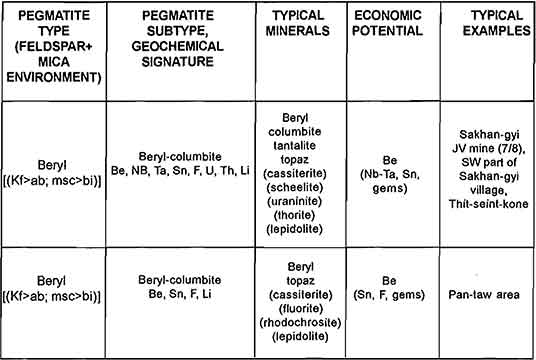 |
| Table 3.1. Classification of pegmatites of the rare-element class for Sakhan-gyi and Pan-taw area, after Cerny (1991). |
Microscopic Study
It shows hypidiomorphic granular, pegmatitic texture, and sometime shows graphic texture. The rock contains only a few minerals which are usually in the form of extremely large crystals. Feldspar and quartz are visible in hand specimen. Most of the alkali-feldspars are weathered and kaolinized and also showing perthilic texture. Small amount of muscovite and lepidolite micas are observed. Sericitization are observed along the cleavage and fracture of alkali-feldspar and some alkali-feldspar showing like a sector twinning.
In aplite, mainly composed of anhedral granular grains of quartz, orthoclase and plagioclase, and apatite, zircon, biotite occurs as accessories. Chalcedonic silica vein and feathery appearing chalcedonic silica cementing quartz and feldspar are also observed.
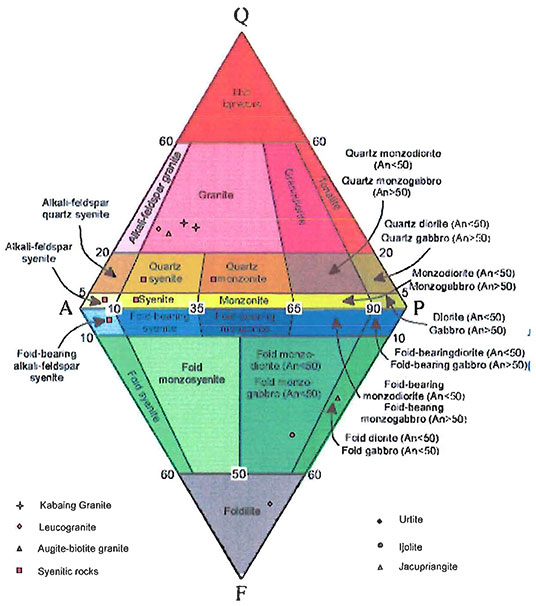 |
| Fig 3.71. Plotted data of the igneous rocks in the Mogok Stone Tract, except ultramafic rocks (Source: IUGS Classification, 2006). Click to enlarge (original image is muddy). |
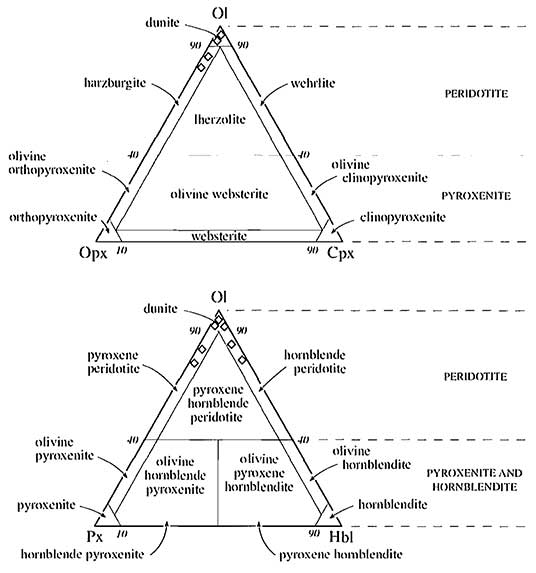 |
| Fig 3.72. Modal classification of ultramafic rocks based on the proportions of olivine (Ol), orthopyroxene (Opx), clinopyroxene (Cpx), pyroxene (Px) and hornblende (Hbl). (Source: IUGS Classification, 2006) |
Thus concludes Chapter III. Access Chapter IV here.
References follow.
References
Adams, E.D., 1926. A visit to the gem districts of Ceylon and Burma. Bull. Can. Inst. Min. Met. v. 166, pp. 213–246.
Barley, M.E, A.L. Pickard, Khin Zaw, P. Rak and M.G. Doyle, 2003. Jurassic to Miocene magmatism and metamorphism in the Mogok metamorphic belt and the Indian-Eurasia collision in Myanmar. Tectonics, v.22, no.3, pp. 1–11.
Bender, F. 1983. Geology of Burma. Gebruder Borntraeger, Berlin, 293 pp.
Bertrand, G, C. Rangin, H. Maluski, Tin Aung Han, Myint Thein, Ohn Myint, Win Maw and San Lwin, 1999. Cenozoic metamorphism along the Shan scarp (Myanmar): evidences for ductile shear along the Sagaing fault or the northward migration of the eastern Himalayan syntaxis. Geophysical Research Letters, v. 26, pp. 915–918.
Bertrand, G., C. Rangin, H. Mluski, H. Bellon and GIAC Scientific Party, 2001. Diachronous cooling along the Mogok Metamorphic Belt (Shan scarp, Myanmar): the trace of the northward migration of the Indian syntaxis. Journal of Asian Earth Sciences, v.19, pp. 649–659.
Brown, C.B. and J.W. Judd, 1896. The rubies of Burma and associated minerals; their mode of occurrence, origin and metamorphoses: a contribution to the history of corundum. Philosophical Transaction of the Royal Society of London. Series A, v. 187, pp. 151–228.
Brook, M., and N.J. Snelling, 1976. K/Ar and Rb/Sr age determinations on rocks and minerals from Burma. Inst. Geol. Sci., London, Isotope Geol. Unit Report 76/12, p.20.
Buddington, A.F., 1959. Granite emplacement with special reference to North America, Geol. Soc. Am. Bull., v. 70. pp. 671–747.
Cerny, P., 1991. Rare-element granitic pegmatite: regional to global environments and petrogenesis. Geosci. Can., v. 18, pt. 2, pp. 68–81.
Chappell, B.W. and A.J.R. White, 1974. Two contrasting granite types. Pacific Geol., v. 8, pp. 173–174.
Clegg, E.L.G. 1941. The Cretaceous and associated rocks of Burma. Mem. Geol. Surv. India, v. 74, pt.1, 101 pp.
Cobbing, E.J., P.E.J. Pitfield, O.P.E. Darbyshire and D.J.J. Mallick, 1992. The granites of the South-East Asian tin belt. Overseas Memoir, British Geological Survey, London, no. 10, 369 pp.
Fermor. L.L., 1932. The Mogok Stone Tract, Katha District. Rec. Geol. Surv. India, v. 65, pt. 1, pp. 80–86.
Hatch, F.H, A.K. Wells and M.K. Wells, 1961. Petrology of the igneous rocks, Thomas Murby, London, 514 pp.
Heron. A. M., 1937, Age of Mogok series, Rec. Geol. Surv. India, v. 72, pt. 1, pp. 62–64.
Hla Kyi, T. Themelis and Kyaw Thu, 2005. The pegmatitic gem deposits of Molo (Momeik) and Sakhan-gyi (Mogok). The Australian Gemmologist, v. 22, no. 7, pp. 303–309.
Hutchison, C.S., 1975. The norm, its variations, their calculation and relationships. Sch. Min. Pet., Mitt., v. 55, pp. 243–256.
Hyndman, D.W, 1985. Petrology of igneous and metamorphic rocks. New York, McGraw-Hill. 2nd edt., 786 pp.
Irvine, T.N. and W.R.A. Barager, 1971. A guide to the chemical classification of the common volcanic rocks. Can. Jour. Earth Sci., v. 8, pp. 523–548.
Iyer, L.A.N., 1953. The geology and gemstones of the Mogok Stone Tract, Burma. Mem. Geol. Surv. India, v. 82, pp. 100.
Kerkvoort, G.V., 1995. Rare metal granitic pegmatites. Unpublished B.Sc. Hons. Thesis, University of Tasmania, Australia, 70 pp.
Khin Zaw, 1986. Geological, petrological, and geochemical characteristics of granitoid rocks in Burma: with special reference to the emplacement of W-Sn mineralisation and their global tectonic implications. Unpublished research paper.
Khin Zaw, 1998. Geological evolution of selected granitic pegmatites in Myanmar (Burma): constraints from regional setting, lithology, and fluid-inclusion studies. International Geology Review, v. 40, pp. 647–662.
La Touche, T.H.D., 1913. Geology of the northern Shan States. Mem. Geol. Surv. India, v. 39, pt. 2, 379 pp.
Maniar, P.D., and P.M. Piccoli, 1989. Tectonic discrimination of granitoids. Geol. Soc. Am. Bull., v. 101, pp. 635–643.
Marmo, A., 1956. On the emplacement of granites. Amer. Jour. of Sci., v. 254, pp. 479–492.
Maung Thein, 2000. Summary of the geological history of Myanmar. Unpublished paper, p.8.
Metcalfe, I., 1998. Origin and assembly of South-East Asia continental terranes. In: Audley Charles, M.G., Hallam, A. (Eds.), Gondwana and Tethys, Special publication Geological Society of London, v. 37, pp. 101–118.
Metcalfe, I., 2000. The Bentong-Raub suture zone. Journal of Southeast Asian Earth Sciences, v. 18, pp. 691–721.
Mitchell, A.H.G., 1977. Tectonic setting for emplacement of Southeast Asia Tin granites. Geological Society of London, v. 141, pp. 123–140.
Mitchell, A.H.G., 1992. Late Permian-Mesozoic events and the Mergui Group nappe in Myanmar and Thailand. Jour. of SE Asia Earth Sciences, v. 7, pp. 165–178.
Mitchell, A.H.G., 1993. Cretaceous-Cenzoic tectonic event in western Myanmar (Burma)—Assam region: Jour. of the Geol. Soc. London, v. 150, pp. 1089–1102.
Mitchell, A.H.G., C.A. Ausa, L. Deiparine, Tin Hlaing, Nyunt Htay and Aung Khine, 2004. The Modi Taung-Nankwe gold district, Slate Belt, central Myanmar: mesothermal veins in a Mesozoic orogen. Journal of Asian Earth Sciences, v. 23, pp. 231–341.
Mitchell, A.H.G., Myint Thein Htay, Kyaw Min Htun, Myint Naing Win, Thura Oo and Tin Hlaing, 2006. Rock relationships in the Mogok metamorphic belt, Tatkon to Mandalay, central Myanmar. Jour. of Asian Earth Sciences. doi:10.1016/j.jseaes.2006.05.009, pp.1–20.
Myint Lwin Thein, Ohn Myint, Sun Kyi and Phone Nyunt Win, 1990. Geology and stratigraphy of the metamorphosed Early Paleozoic rocks of the Mogok-Thabeikkyin-Singu-Madaya areas. Unpublished staff report, no. 98, A.G.D., Y.U., p.24.
O’Connor, J.T., 1965. Classification of quartz-rich igneous rocks based on feldspar ratios. U.S.G.S. Prof. Paper. 525B, pp. 79–84.
Piwinskii, and P.J. Wyllie, 1970. Experimental studies of igneous rock series: felsic body suite from the Neddle point pluton, Wallowa Batholith, Oregon. Jour. Geol. v. 78, pp. 52–76.
Ridd, M.F., 1971. South-East Asia as a part of Gondwana land. Nature, v. 234, pp. 531–533.
Rossman, G.R., Saw Naung Oo, G.E. Harlow and J. Hunt, 2005. A second source in Myanmar and metasomatic origins. Goldschmidt Conference Abstract, Geochemistry of Gem Deposits Sec., pp. 278–279.
Searle, D.L. and Ba Than Haq, 1964. The Mogok belt of Burma and its relationship to the Himalayan orogeny. in Int. Geol. Cong., Twenty-Second Sec., India, Himalayan and Alpine orogeny, Sec. 11, pp. 132–161.
Sein Myint, Than Naing and Soe Nyunt Swe, 1979. Satellite imagery interpretation of major lineaments in part of northeastern Burma. Contribution to Burmese Geology, v. 1, no. 1. pp. 20–25.
Smirnov, V.I., 1976. Geology of mineral deposits. MIR Publishers, Moscow, 520 pp.
Sutherland, F.L., D. Schwarrz, E.A. Jobbins, R.R. Coenraads and G. Webb, 1998. Distinctive gem corundum suites from discrete basalt fields: a comparative study of Barrington, Australia, and West Pailin, Cambodia gem fields. Journal of Gemmology, v. 26, pp. 65–85.
Sylvester, P. J., 1989. Post-collision alkaline granites. Jour. of Geol., v. 97, pp. 261–280.
Thet Tin Nyunt, 2000. Mineralogical and petrological studies of Bemard-Pyaunggaung area, Mogok Township, Mandalay Division. Unpublished M.Sc. Thesis, University of Yangon, 184 pp.
Thuzar Aung, 2003. Petrology and Gemstones of Ondan and its Environs, Mogok Township, Mandalay Division. Unpublished M.Res. Thesis, University of Yangon, 90 pp.
Tuttle, O. F., and N.L. Bowen, 1958. Origin of granite in the light of experimental studies in the system NaAISip8-KAISiP8-Si02-H20. In: Hyundman, D.W., 1985. Petrology of igneous and metamorphic rocks. New York, McGraw-Hill. 2nd edt., 786 pp.
United Nations, 1978. Geology and exploration geochemistry of the Shan scarps area, east of Kyaukse, Thazi and Tatkon, central Burma. Technical Report. UN/BUR 721002, no. 3, United Nations Development Programme, New York.
Washington, H.S., 1917; Chemical analyses of igneous rocks published from 1884 to 1913, inclusive. U.S. Geol. Survey Prof. Paper, no. 99, pp. 9–1201.
Wiebe, R.A., 1974. Differentiation in layered diorite intrusions, Ingonish, Nova Scotia. Jour. Geol., v. 82, pp. 731–750.
Williams. H., F.J. Turner and C.M. Gilbert, 1982. Petrography; an introduction of the study of rocks in thin section. 2nd ed. W.H. Freeman and Co., San Francisco, 626 pp.
Win Naing, 2001. Tertiary deformation patterns of the northeastern part of Myanmar: structural and microfabric evidences from the Mogok-Momeik area. Unpublished M.Res. Thesis, Dept. of Geol., University of Yangon 198 pp.
Wright, J.B., 1969. A simple alkalinity ratio and its application to questions of non-orogenic granite gneiss. Geol. Mag., v. 106, pp. 523–548.
